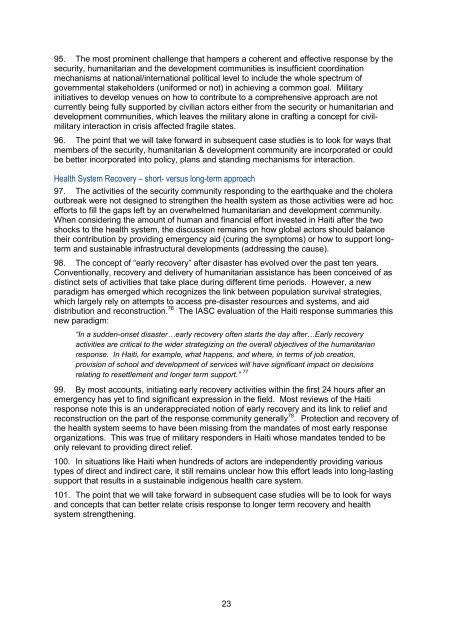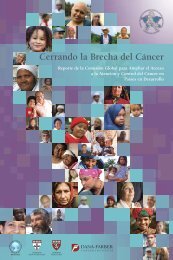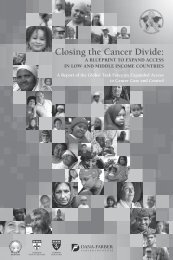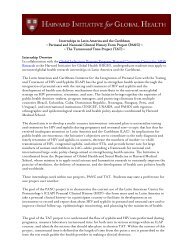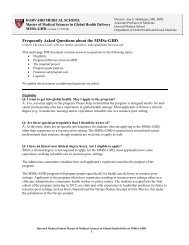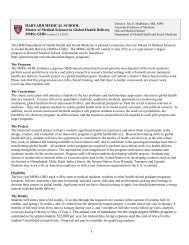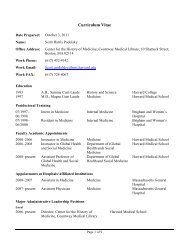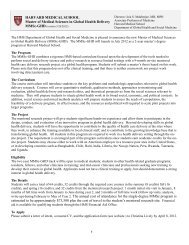Haiti Case Study - The Department of Global Health and Social ...
Haiti Case Study - The Department of Global Health and Social ...
Haiti Case Study - The Department of Global Health and Social ...
Create successful ePaper yourself
Turn your PDF publications into a flip-book with our unique Google optimized e-Paper software.
95. <strong>The</strong> most prominent challenge that hampers a coherent <strong>and</strong> effective response by the<br />
security, humanitarian <strong>and</strong> the development communities is insufficient coordination<br />
mechanisms at national/international political level to include the whole spectrum <strong>of</strong><br />
governmental stakeholders (uniformed or not) in achieving a common goal. Military<br />
initiatives to develop venues on how to contribute to a comprehensive approach are not<br />
currently being fully supported by civilian actors either from the security or humanitarian <strong>and</strong><br />
development communities, which leaves the military alone in crafting a concept for civilmilitary<br />
interaction in crisis affected fragile states.<br />
96. <strong>The</strong> point that we will take forward in subsequent case studies is to look for ways that<br />
members <strong>of</strong> the security, humanitarian & development community are incorporated or could<br />
be better incorporated into policy, plans <strong>and</strong> st<strong>and</strong>ing mechanisms for interaction.<br />
<strong>Health</strong> System Recovery – short- versus long-term approach<br />
97. <strong>The</strong> activities <strong>of</strong> the security community responding to the earthquake <strong>and</strong> the cholera<br />
outbreak were not designed to strengthen the health system as those activities were ad hoc<br />
efforts to fill the gaps left by an overwhelmed humanitarian <strong>and</strong> development community.<br />
When considering the amount <strong>of</strong> human <strong>and</strong> financial effort invested in <strong>Haiti</strong> after the two<br />
shocks to the health system, the discussion remains on how global actors should balance<br />
their contribution by providing emergency aid (curing the symptoms) or how to support longterm<br />
<strong>and</strong> sustainable infrastructural developments (addressing the cause).<br />
98. <strong>The</strong> concept <strong>of</strong> “early recovery” after disaster has evolved over the past ten years.<br />
Conventionally, recovery <strong>and</strong> delivery <strong>of</strong> humanitarian assistance has been conceived <strong>of</strong> as<br />
distinct sets <strong>of</strong> activities that take place during different time periods. However, a new<br />
paradigm has emerged which recognizes the link between population survival strategies,<br />
which largely rely on attempts to access pre-disaster resources <strong>and</strong> systems, <strong>and</strong> aid<br />
distribution <strong>and</strong> reconstruction. 76 <strong>The</strong> IASC evaluation <strong>of</strong> the <strong>Haiti</strong> response summaries this<br />
new paradigm:<br />
“In a sudden-onset disaster…early recovery <strong>of</strong>ten starts the day after…Early recovery<br />
activities are critical to the wider strategizing on the overall objectives <strong>of</strong> the humanitarian<br />
response. In <strong>Haiti</strong>, for example, what happens, <strong>and</strong> where, in terms <strong>of</strong> job creation,<br />
provision <strong>of</strong> school <strong>and</strong> development <strong>of</strong> services will have significant impact on decisions<br />
relating to resettlement <strong>and</strong> longer term support.” 77<br />
99. By most accounts, initiating early recovery activities within the first 24 hours after an<br />
emergency has yet to find significant expression in the field. Most reviews <strong>of</strong> the <strong>Haiti</strong><br />
response note this is an underappreciated notion <strong>of</strong> early recovery <strong>and</strong> its link to relief <strong>and</strong><br />
reconstruction on the part <strong>of</strong> the response community generally 78 . Protection <strong>and</strong> recovery <strong>of</strong><br />
the health system seems to have been missing from the m<strong>and</strong>ates <strong>of</strong> most early response<br />
organizations. This was true <strong>of</strong> military responders in <strong>Haiti</strong> whose m<strong>and</strong>ates tended to be<br />
only relevant to providing direct relief.<br />
100. In situations like <strong>Haiti</strong> when hundreds <strong>of</strong> actors are independently providing various<br />
types <strong>of</strong> direct <strong>and</strong> indirect care, it still remains unclear how this effort leads into long-lasting<br />
support that results in a sustainable indigenous health care system.<br />
101. <strong>The</strong> point that we will take forward in subsequent case studies will be to look for ways<br />
<strong>and</strong> concepts that can better relate crisis response to longer term recovery <strong>and</strong> health<br />
system strengthening.<br />
23


